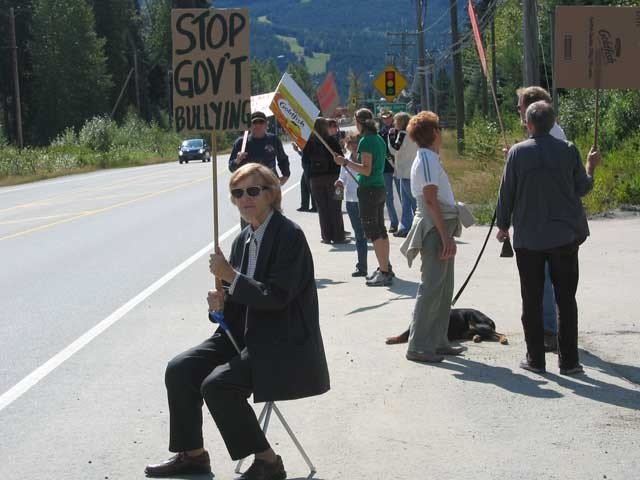Even though grubbing began on a B.C. Hydro wetland last week, concerned Whistler citizens joined together Sunday afternoon to protest B.C. Transit’s site for the new transit facility.
Armed with signs and cowbells, about 20 people took to the street Aug. 31 and rallied outside the Rainbow Substation, just north of Nesters. The peaceful protest was met by a chorus of honks as vehicles drove by on Highway 99. No RCMP officers were at the event.
Organizer Kelly Lee-Richards said she decided to plan the protest because “we want accountability.”
“I am just trying to draw attention to all of this, make sure people know, and to come out and support us because this is just the first,” she said, despite the fact that the land has already been cleared of most vegetation.
“We have already had Lots 1/9 go down, and this is just another one that is going down. And it is all for the Olympics.”
Sara Jennings, who protested as a concerned citizen, not as president of the Association of Whistler Area Residents (AWARE), added that the high number of car honks shows that the community supports the protesters.
“I have not heard many people speak positively about this thing,” said Jennings.
“Whistler, as far as I know, pretty much is united against this.”
At issue is B.C. Transit’s decision to build a new bus hub on B.C. Hydro property, which is partly wetland. The Crown agency says it has been looking for a suitable site for the facility for two years, and there are no other viable options.
Protesters, on the other hand, say that a valuable ecosystem should not be paved over to make way for the provincially- and federally-funded 20 hydrogen buses coming in 2009.
Since the disputed land is owned by B.C. Hydro, another Crown corporation, it is exempt from the municipality’s regulations, including its policy of protecting wetlands. Despite this loophole, the municipality said it supports B.C. Transit’s selection, and two weeks ago council reluctantly voted to formerly endorse the proposal.
Several people in the community are not willing to let the issue rest, however, and another protest has already been planned for Sunday, Sept. 7. Depending on how that protest goes, organizers may decide to make it a weekly event.
Protester Pina Belperio wants to push for another environmental assessment of the area.
Several protesters are also asking why the municipality did not push harder to put the facility on the BCBC Lands. The already disturbed site is currently owned by the Squamish and Lil’wat First Nations but is in the process of being transferred to the municipality.
Bill Barratt, chief administrative officer for the municipality, said on Tuesday that B.C. Transit officials did look at the site but thought it was too small for their needs.
And, to further draw attention to her
concerns, Lee-Richards has also been circulating B.C. Transit’s assessment of
the wetland, along with comments from an anonymous qualified expert critiquing
the report.
Despite these efforts, B.C. Transit paid little attention to Sunday’s protest, and no one at the Crown agency was available for comment this week.
But further down the Sea to Sky Corridor, other environmental groups are keeping a close eye on the situation in Whistler, including the Squamish River Watershed Society and The Squamish Environmental Conservation Society, who also came out to protest this weekend.




